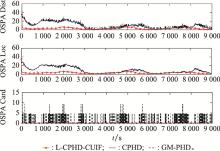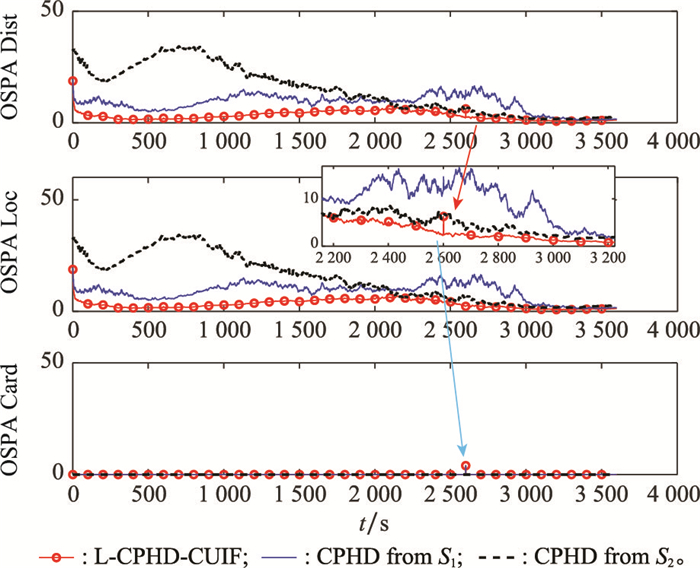Systems Engineering and Electronics ›› 2024, Vol. 46 ›› Issue (8): 2789-2797.doi: 10.12305/j.issn.1001-506X.2024.08.26
• Guidance, Navigation and Control • Previous Articles Next Articles
Space multi-target tracking method for space-based distributedpassive detection
Linhai JIANG1, Baichun GONG1,*, Chuankai LIU2,3, Yang YANG4, Renyong ZHANG5
- 1. College of Astronautics, Nanjing University of Aeronautics and Astronautics, Nanjing 210016, China
2. Beijing Aerospace Control Center, Beijing 100190, China
3. Key Laboratory of Science and Technology on Space Flight Dynamics, Beijing 100190, China
4. School of Mechanical and Manufacturing Engineering, University of New South Wales, Sydney 2052, Australia
5. Technology and Engineering Center for Space Utilization, Chinese Academy of Science, Beijing 100094, China
-
Received:2023-05-30Online:2024-07-25Published:2024-08-07 -
Contact:Baichun GONG
CLC Number:
Cite this article
Linhai JIANG, Baichun GONG, Chuankai LIU, Yang YANG, Renyong ZHANG. Space multi-target tracking method for space-based distributedpassive detection[J]. Systems Engineering and Electronics, 2024, 46(8): 2789-2797.
share this article
Table 1
Orbit parameters of observed targets in initial time"
| 观测目标 | 半长轴/km | 偏心率 | 轨道倾角/(°) | 升交点赤经/(°) | 近地点幅角/(°) | 真近点角/(°) |
| 1 | 6 929.38 | 0.001 5 | 53.064 5 | 120.978 0 | 99.867 1 | 54.098 2 |
| 2 | 6 927.50 | 0.001 4 | 53.061 0 | 140.972 0 | 88.136 4 | 55.803 9 |
| 3 | 6 926.47 | 0.001 4 | 53.058 1 | 130.970 0 | 83.196 9 | 55.591 9 |
| 4 | 6 930.13 | 0.001 5 | 53.069 3 | 276.013 0 | 68.025 0 | 313.121 0 |
| 5 | 6 924.86 | 0.001 2 | 53.052 1 | 135.989 0 | 74.161 9 | 57.256 9 |
| 6 | 6 929.76 | 0.001 5 | 53.068 0 | 261.030 0 | 70.070 4 | 313.644 0 |
| 7 | 6 936.80 | 0.001 5 | 53.065 7 | 126.252 0 | 99.705 0 | 53.965 7 |
| 8 | 6 927.46 | 0.001 4 | 53.060 6 | 266.040 0 | 83.906 2 | 312.351 0 |
| 9 | 6 931.56 | 0.001 4 | 53.073 6 | 286.017 0 | 54.641 4 | 311.644 0 |
| 10 | 6 928.87 | 0.001 5 | 53.067 3 | 271.036 0 | 76.033 8 | 312.736 0 |
| 11 | 6 927.99 | 0.001 5 | 53.060 9 | 125.988 0 | 89.882 2 | 56.610 3 |
| 12 | 6 958.21 | 0.001 1 | 70.007 4 | 110.321 0 | 88.119 8 | 65.339 5 |
| 13 | 6 921.55 | 0.001 5 | 53.228 0 | 263.531 0 | 71.967 5 | 316.093 0 |
| 14 | 6 923.37 | 0.001 6 | 53.232 8 | 273.509 0 | 58.692 1 | 315.114 0 |
| 15 | 6 922.64 | 0.001 5 | 53.227 4 | 123.490 0 | 101.756 0 | 56.596 1 |
| 1 |
CAI H , YANG Y , GEHLY S , et al.Sensor tasking for search and catalog maintenance of geosynchronous space objects[J].Acta Astronautica,2020,175,234-248.
doi: 10.1016/j.actaastro.2020.05.063 |
| 2 |
HU Y P , LI K B , LIANG Y G , et al.Review on strategies of space-based optical space situational awareness[J].Journal of Systems Engineering and Electronics,2021,32(5):1152-1166.
doi: 10.23919/JSEE.2021.000099 |
| 3 |
ZHANG Y J , WANG J Q , HOU B W , et al.Optimal maneuvering strategy of spacecraft evasion based on angles-only measurement and observability analysis[J].Journal of Systems Engineering and Electronics,2023,34(1):172-184.
doi: 10.23919/JSEE.2023.000026 |
| 4 | 龚柏春, 金鑫, 张仁勇, 等.基于相对角动量的空间非合作目标机动仅测角检测方法[J].系统工程与电子技术,2023,45(3):814-821. |
| GONG B C , JIN X , ZHANG R Y , et al.Angle-only measurement maneuver detecting method for space non-cooperative target based on relative angular momentum[J].Systems Engineering and Electronics,2023,45(3):814-821. | |
| 5 | JIANG K, ZHOU J J, LYU R G, et al. Multi-target tracking algorithm of vehicle-mounted millimeter-wave radar based on IMM-JPDA-STUKF[C]//Proc. of the 4th International Confe-rence on Electronic Engineering and Informatics, 2022. |
| 6 |
MORAWSKA B , LIPINSKI P , LICHY K , et al.Transfer learning-based UWB indoor localization using MHT-MDC and clusterization-based sparse fingerprinting[J].Journal of Computational Science,2022,61,101654.
doi: 10.1016/j.jocs.2022.101654 |
| 7 |
LINDENMAIER L , ARADI S , BECSI T , et al.GM-PHD filter based sensor data fusion for automotive frontal perception system[J].IEEE Trans.on Vehicular Technology,2022,71(7):7215-7229.
doi: 10.1109/TVT.2022.3171040 |
| 8 |
XU C A , YAO L B , LIU Y , et al.A novel SMC-PHD filter for multi-target tracking without clustering[J].Displays,2022,71,102113.
doi: 10.1016/j.displa.2021.102113 |
| 9 |
LI T , HLAWATSCH F .A distributed particle-PHD filter using arithmetic-average fusion of Gaussian mixture parameters[J].Information Fusion,2021,73,111-124.
doi: 10.1016/j.inffus.2021.02.020 |
| 10 | GARCIA-FERNANDEZ A F, RALPH J, HORRIDGE P, et al. Gaussian trajectory PMBM filter with nonlinear measurements based on posterior linearisation[C]//Proc. of the IEEE 25th International Conference on Information Fusion, 2022. |
| 11 |
WANG Y , RAO P , CHEN X .Robust PMBM filter with unknown detection probability based on feature estimation[J].Sensors,2022,22(10):3730.
doi: 10.3390/s22103730 |
| 12 | LI G C , KONG L J , YI W , et al.Multiple model Poisson multi-Bernoulli mixture filter for maneuvering targets[J].IEEE Sensors Journal,2020,21(3):3143-3154. |
| 13 |
HUANG Q , XIE L , SU H Y .Estimations of time-varying birth cardinality distribution and birth intensity in Gaussian mixture CPHD filter for multi-target tracking[J].Signal Processing,2022,190,108321.
doi: 10.1016/j.sigpro.2021.108321 |
| 14 |
KIM S Y , KANG C H , PARK C G .SMC-CPHD filter with adaptive survival probability for multiple frequency tracking[J].Applied Sciences,2022,12(3):1369.
doi: 10.3390/app12031369 |
| 15 |
LEONARD M R , ZOUBIR A M .Multi-target tracking in distributed sensor networks using particle PHD filters[J].Signal Processing,2019,159,130-146.
doi: 10.1016/j.sigpro.2019.01.020 |
| 16 |
LIU Z , JI L N , YANG F B , et al.Cubature information Gaussian mixture probability hypothesis density approach for multi extended target tracking[J].IEEE Access,2019,7,103678-103692.
doi: 10.1109/ACCESS.2019.2931470 |
| 17 |
KIM H , GRANSTROM K , GAO L , et al.5G mmWave coope-rative positioning and mapping using multi-model PHD filter and map fusion[J].IEEE Trans.on Wireless Communications,2020,19(6):3782-3795.
doi: 10.1109/TWC.2020.2978479 |
| 18 |
TANG T , HONG T , HONG H H , et al.An improved UAV-PHD filter-based trajectory tracking algorithm for multi-UAVs in future 5G IoT scenar ios[J].Electronics,2019,8(10):1188.
doi: 10.3390/electronics8101188 |
| 19 |
KIM H , GRANSTROM K , SVENSSON L , et al.PMBM-based SLAM filters in 5G mmWave vehicular networks[J].IEEE Trans. on Vehicular Technology,2022,71(8):8646-8661.
doi: 10.1109/TVT.2022.3174403 |
| 20 |
GONG B C , WANG S , LI S , et al.Review of space relative navigation based on angles-only measurements[J].Astrodynamics,2023,7(2):131-152.
doi: 10.1007/s42064-022-0152-2 |
| 21 | 何友, 姚力波, 李刚, 等.多源卫星信息在轨融合处理分析与展望[J].宇航学报,2021,42(1):1-10. |
| HE Y , YAO L B , LI G , et al.Summary and future development of on-board information fusion for multi-satellite collaborative observation[J].Journal of Astronautics,2021,42(1):1-10. | |
| 22 |
LI G , BATTISTELLI G , YI W , et al.Distributed multi-sensor multi-view fusion based on generalized covariance intersection[J].Signal Processing,2020,166,107246.
doi: 10.1016/j.sigpro.2019.107246 |
| 23 |
丁自然, 刘瑜, 曲建跃, 等.基于节点通信度的信息加权一致性滤波[J].系统工程与电子技术,2020,42(10):2181-2188.
doi: 10.3969/j.issn.1001-506X.2020.10.05 |
|
DING Z R , LIU Y , QU J Y , et al.Information weighted consensus filter algorithm based on node communication degree[J].Systems Engineering and Electronics,2020,42(10):2181-2188.
doi: 10.3969/j.issn.1001-506X.2020.10.05 |
|
| 24 |
MILLAN P , ORIHUELA L , VIVAS C , et al.Distributed consensus-based estimation considering network induced delays and dropouts[J].Automatica,2012,48(10):2726-2729.
doi: 10.1016/j.automatica.2012.06.093 |
| 25 | LI Z, WANG Y D, ZHENG W. Adaptive consensus-based unscented information filter for distributed space target tracking[C]//Proc. of the 5th Chinese Conference on Swarm Intelligence and Cooperative Control, 2023: 964-974. |
| 26 | LIU J , LIU Y , DONG K , et al.Distributed hybrid consensus-based square-root cubature quadrature information filter and its application to maneuvering target tracking[J].International Journal of Distributed Sensor Networks,2019,15(12):155014771989595. |
| 27 | CURTIS H D .Orbital mechanics for engineering students[M].Oxford: Butterworth-Heinemann,2013. |
| 28 | 靳旭红, 黄飞, 程晓丽, 等.超低地球轨道卫星大气阻力预测与影响因素分析[J].清华大学学报(自然科学版),2020,60(3):219-226. |
| JIN X H , HUANG F , CHENG X L , et al.Atmospheric drag on satellites flying in l ower low-earth orbit[J].Journal of Tsinghua University (Science and Technology),2020,60(3):219-226. | |
| 29 |
FELDMAN D , SCHMIDT M , SOHLER C .Turning big data into tiny data: constant-size coresets for K-means, PCA, and projective clustering[J].SIAM Journal on Computing,2020,49(3):601-657.
doi: 10.1137/18M1209854 |
| 30 |
LIU G L , TIAN G H .Square-root sigma-point information consensus filters for distributed nonlinear estimation[J].Sensors,2017,17(4):800.
doi: 10.3390/s17040800 |
| 31 |
RISTIC B , VO B N , CLARK D , et al.A metric for perfor-mance evaluation of multi-target tracking algorithms[J].IEEE Trans.on Signal Processing,2011,59(7):3452-3457.
doi: 10.1109/TSP.2011.2140111 |
| [1] | Siyi YAO, Wanchun LI, Lin GAO, Huaguo ZHANG, Hangwei HU. Multi-sensor multi-target tracking based on distributed PMHT [J]. Systems Engineering and Electronics, 2024, 46(7): 2184-2190. |
| [2] | Yaling ZHUO, Xiang LI, Lei ZUO, Juan HU. Power allocation algorithm with random data packet loss in netted radar [J]. Systems Engineering and Electronics, 2024, 46(6): 1957-1966. |
| [3] | Meibin QI, Shuo ZHUANG, Jingjing HU, Yanfang YANG, Yuankui HU. Resolvable group target tracking based on joint GLMB filter [J]. Systems Engineering and Electronics, 2024, 46(4): 1212-1219. |
| [4] | Shuya ZENG, Bin RAO. Ballistic target association method based on dynamic conservation law [J]. Systems Engineering and Electronics, 2024, 46(2): 684-691. |
| [5] | Wenhao BI, Jie ZHOU, An ZHANG, Li LIU. JPDA algorithm based on maximum entropy fuzzy clustering in clutter environment [J]. Systems Engineering and Electronics, 2023, 45(7): 1920-1927. |
| [6] | Zhengwei LIU, Ying CHEN, Yaobing LU. PHD filter for small-angle crossing of multi-target trajectories [J]. Systems Engineering and Electronics, 2023, 45(4): 982-990. |
| [7] | Lei AN, Zhaorui LI, Bing JI. Non-myopic scheduling method for mobile active/passive sensor in clutter environment [J]. Systems Engineering and Electronics, 2023, 45(1): 165-174. |
| [8] | Zizhuang SONG, Jiawei YANG, Dongfang ZHANG, Shiqiang WANG, Shuo ZHANG. Real-time infrared multi-class multi-target anchor-free tracking network [J]. Systems Engineering and Electronics, 2022, 44(2): 401-409. |
| [9] | Lifan YIN, Yiqun ZHANG, Shuo WANG, Chenggang SUN. A survey on histogram probabilistic multi-hypothesis tracker technique [J]. Systems Engineering and Electronics, 2021, 43(11): 3118-3125. |
| [10] | Zhengjie LI, Junwei XIE, Haowei ZHANG, Zhaojian ZHANG. Joint power and bandwidth allocation algorithm based on collocated MIMO radar [J]. Systems Engineering and Electronics, 2020, 42(5): 1041-1049. |
| [11] | Xiaodong LU, Tao CUI, Wei WANG, Cheng CHENG. Multi-target labeled multi-Bernoulli filter with time-delay and registration errors [J]. Systems Engineering and Electronics, 2020, 42(4): 904-911. |
| [12] | PENG Huafu, HUANG Gaoming, TIAN Wei, QIU Hao. Labeled multi-Bernoulli filter based on amplitude information [J]. Systems Engineering and Electronics, 2018, 40(12): 2636-2641. |
| [13] | LIU Jianye, WANG Hua, ZHOU Wanmeng. LEO constellation sensor resources scheduling algorithm based on Genetic and Simulated annealing [J]. Systems Engineering and Electronics, 2018, 40(11): 2476-. |
| [14] | GU Xiaolin, ZHOU Shilin, LEI Lin. Multi-target tracking based on m-best data association and tracklet associatio [J]. Systems Engineering and Electronics, 2017, 39(7): 1640-1646. |
| [15] | YUAN Changshun, WANG Jun, XIANG Hong, SUN Jinping. Adaptive δ-GLMB filtering algorithm based on VB approximation [J]. Systems Engineering and Electronics, 2017, 39(2): 237-243. |
| Viewed | ||||||
|
Full text |
|
|||||
|
Abstract |
|
|||||















